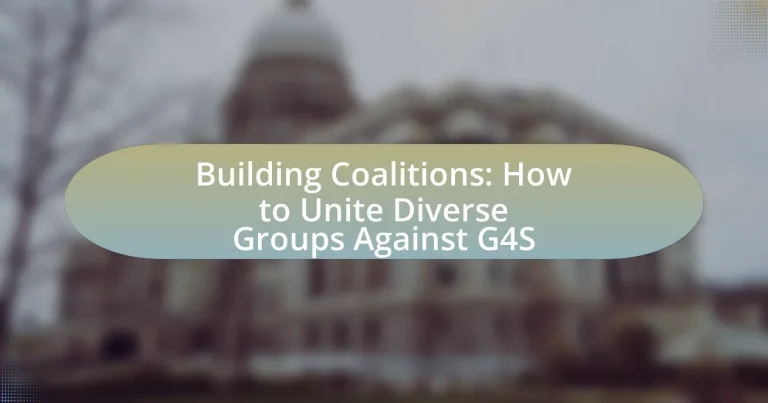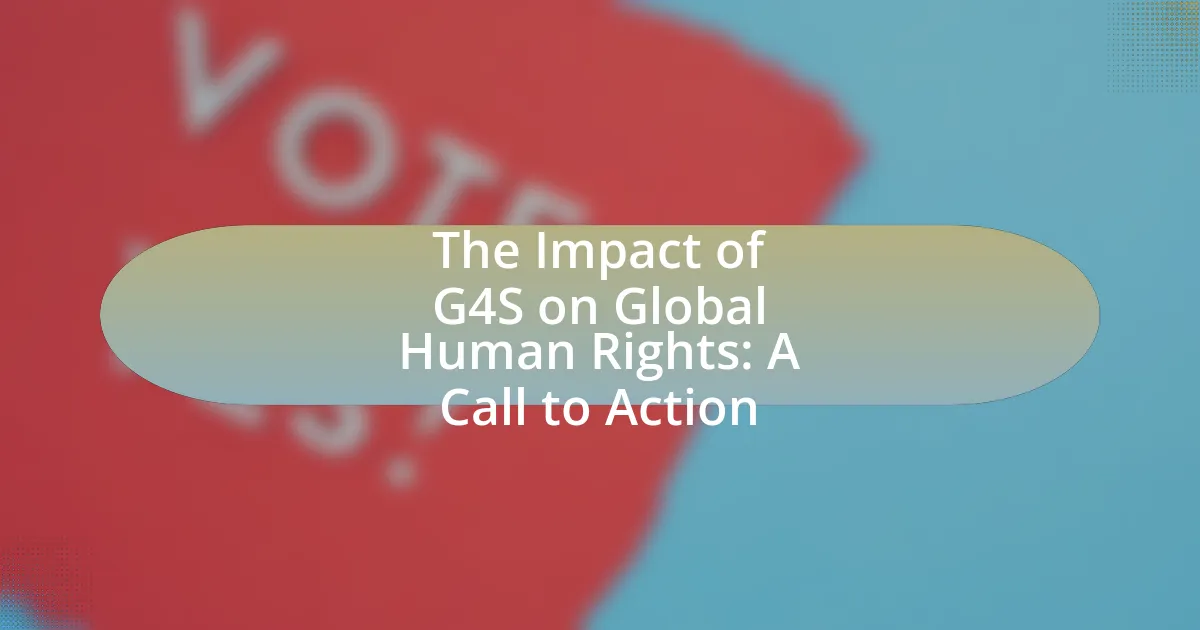The article focuses on building coalitions to unite diverse groups against G4S, a global security company criticized for human rights violations. It outlines the importance of coalition-building, highlighting how collaboration among human rights activists, labor unions, and community organizations can amplify their collective power and influence. The article discusses historical examples of successful coalitions, the challenges faced in forming these alliances, and effective strategies for maintaining momentum and engagement. Additionally, it emphasizes the role of communication, grassroots organizing, and advocacy tactics in effectively opposing G4S and measuring the impact of coalition efforts.
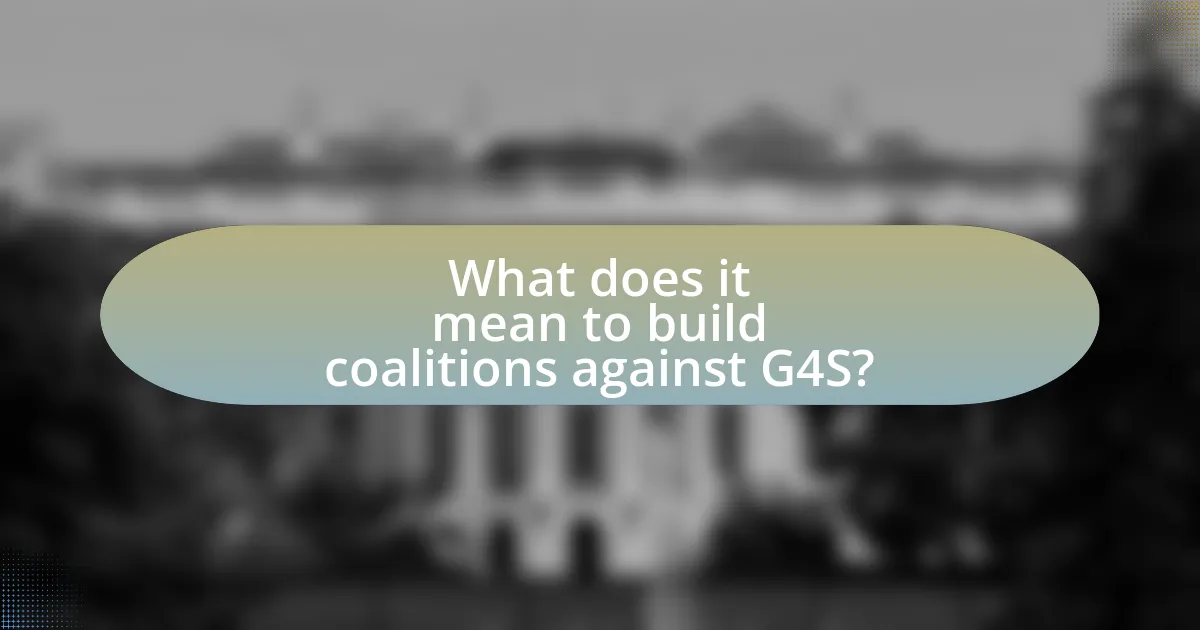
What does it mean to build coalitions against G4S?
Building coalitions against G4S means uniting various organizations, communities, and individuals to collectively oppose the practices and policies of G4S, a global security company often criticized for its involvement in human rights violations. This process involves collaboration among diverse groups, such as human rights activists, labor unions, and community organizations, to amplify their voices and create a stronger impact against G4S’s operations. Evidence of this approach can be seen in campaigns that have successfully pressured institutions to divest from G4S, demonstrating the effectiveness of collective action in challenging corporate practices.
Why is coalition-building important in opposing G4S?
Coalition-building is important in opposing G4S because it amplifies collective power and resources against a common adversary. By uniting diverse groups, such as human rights organizations, labor unions, and community activists, the coalition can leverage a broader base of support, share expertise, and coordinate strategies effectively. Historical examples, such as the successful campaigns against apartheid in South Africa, demonstrate that coalitions can mobilize public opinion and influence policy changes. Additionally, a coalition can create a more inclusive dialogue, ensuring that various perspectives are represented, which strengthens the overall opposition to G4S’s practices and policies.
What historical examples illustrate successful coalition-building against corporations?
Successful coalition-building against corporations is exemplified by the United Farm Workers (UFW) movement in the 1960s and 1970s. The UFW, led by Cesar Chavez, united farmworkers, labor unions, and civil rights organizations to advocate for better working conditions and wages in the agricultural sector. This coalition successfully pressured major agricultural companies, resulting in significant labor contracts and improved rights for workers. Another notable example is the anti-apartheid movement, which brought together various global coalitions, including labor unions, religious groups, and political organizations, to oppose companies operating in South Africa. This collective action led to economic sanctions and ultimately contributed to the dismantling of apartheid. These historical instances demonstrate the effectiveness of diverse groups uniting against corporate interests to achieve social and economic justice.
How can diverse groups benefit from uniting against a common adversary?
Diverse groups can benefit from uniting against a common adversary by leveraging their unique strengths and perspectives to create a more powerful collective force. This unity enhances resource sharing, amplifies voices, and fosters innovative solutions that may not emerge within homogeneous groups. Historical examples, such as the Civil Rights Movement in the United States, demonstrate that diverse coalitions can effectively challenge systemic injustices by combining various strategies and mobilizing broader support. Additionally, research indicates that diverse teams outperform homogeneous ones in problem-solving and creativity, which can be crucial when addressing complex challenges posed by a common adversary.
What challenges do diverse groups face when forming coalitions against G4S?
Diverse groups face significant challenges when forming coalitions against G4S, primarily due to differing priorities, communication barriers, and varying levels of resources. These differences can lead to misunderstandings and conflicts over goals, making it difficult to establish a unified agenda. For instance, groups focused on human rights may prioritize different issues than those concerned with labor rights, complicating coalition-building efforts. Additionally, language and cultural differences can hinder effective communication, resulting in misinterpretations of intentions and strategies. Resource disparities also pose a challenge, as some groups may lack the funding or organizational capacity to engage fully in coalition activities, leading to unequal participation and influence within the coalition.
How do differing agendas impact coalition effectiveness?
Differing agendas significantly hinder coalition effectiveness by creating conflicts that impede collaboration and decision-making. When coalition members prioritize their individual goals over collective objectives, it leads to misalignment and reduces the group’s ability to act cohesively. For instance, research by the National Democratic Institute highlights that coalitions with clear, shared goals are more successful in achieving their objectives, while those with divergent agendas often struggle to maintain unity and focus. This misalignment can result in wasted resources, decreased morale, and ultimately, failure to achieve the coalition’s intended impact.
What strategies can mitigate conflicts among coalition members?
Effective strategies to mitigate conflicts among coalition members include establishing clear communication channels, fostering mutual respect, and implementing conflict resolution mechanisms. Clear communication ensures that all members understand their roles and expectations, reducing misunderstandings that can lead to conflict. Fostering mutual respect among members encourages collaboration and minimizes tensions, as members feel valued and heard. Additionally, implementing conflict resolution mechanisms, such as mediation or facilitated discussions, provides structured approaches to address disputes when they arise. Research indicates that coalitions with strong communication and conflict resolution strategies are more successful in achieving their goals, as evidenced by studies on collaborative governance (Ansell & Gash, 2008).
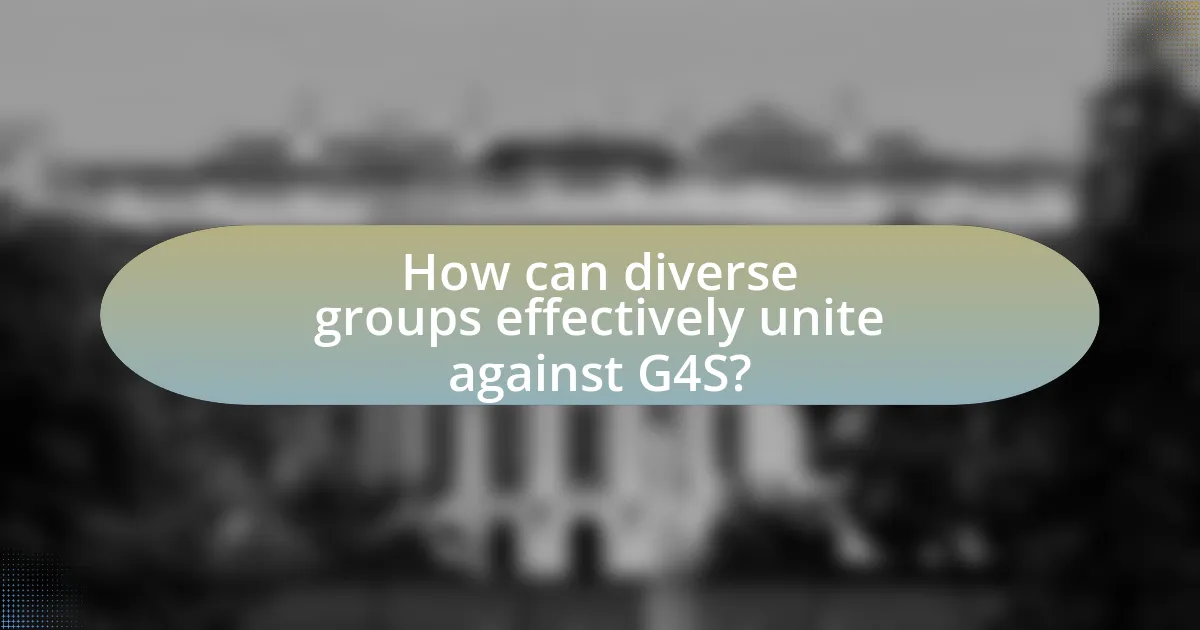
How can diverse groups effectively unite against G4S?
Diverse groups can effectively unite against G4S by establishing a common platform that emphasizes shared goals and values, such as human rights and social justice. This coalition-building involves identifying overlapping interests among various organizations, including labor unions, human rights advocates, and community groups, to create a unified front. For instance, the coalition can leverage collective campaigns, such as protests or awareness initiatives, to amplify their message and increase visibility. Historical examples, like the successful collaboration of various civil rights organizations during the anti-apartheid movement, demonstrate that diverse groups can achieve significant impact when they align their efforts against a common adversary.
What steps are essential for initiating a coalition against G4S?
To initiate a coalition against G4S, the essential steps include identifying common goals, engaging stakeholders, and establishing a clear communication strategy. First, defining shared objectives among diverse groups ensures alignment and purpose. Next, reaching out to potential coalition members, such as community organizations, advocacy groups, and affected individuals, fosters inclusivity and broadens support. Finally, creating a communication plan that outlines how the coalition will share information and mobilize efforts is crucial for maintaining cohesion and effectiveness. These steps are validated by successful coalition-building examples in social justice movements, where clear objectives and strong communication have led to impactful outcomes.
How can leaders identify and engage potential coalition partners?
Leaders can identify and engage potential coalition partners by conducting thorough stakeholder analysis and leveraging existing networks. Stakeholder analysis involves mapping out individuals and organizations that share common goals or interests related to the coalition’s objectives, such as opposing G4S. Engaging these partners can be achieved through targeted outreach, including personalized communication and collaborative initiatives that highlight mutual benefits. Research indicates that successful coalitions often emerge from shared values and clear communication, which fosters trust and commitment among partners.
What role does communication play in coalition formation?
Communication is essential in coalition formation as it facilitates understanding, alignment of goals, and trust among diverse groups. Effective communication allows coalition members to articulate their interests, negotiate terms, and build consensus, which is crucial for uniting different stakeholders against a common adversary, such as G4S. Research indicates that successful coalitions often rely on transparent dialogue and shared narratives to foster collaboration, as seen in various social movements where coordinated messaging has led to increased solidarity and action.
How can coalitions maintain momentum and effectiveness over time?
Coalitions can maintain momentum and effectiveness over time by establishing clear goals, fostering strong communication, and ensuring active participation from all members. Clear goals provide a shared vision that aligns the coalition’s efforts, while strong communication facilitates transparency and trust among members, which is essential for collaboration. Active participation encourages commitment and ownership, leading to sustained engagement. Research indicates that coalitions with defined objectives and regular communication are more likely to achieve long-term success, as evidenced by the Coalition for Healthier Cities and Communities, which demonstrated improved health outcomes through sustained member involvement and clear strategic planning.
What strategies can be employed to keep coalition members motivated?
To keep coalition members motivated, establishing clear goals and fostering open communication are essential strategies. Clear goals provide direction and a sense of purpose, which can enhance commitment among members. For instance, research by the Project Management Institute indicates that teams with well-defined objectives are 20% more productive. Open communication encourages collaboration and allows members to voice concerns and share ideas, which can strengthen relationships and increase engagement. Additionally, recognizing and celebrating achievements, no matter how small, can boost morale and reinforce a sense of belonging within the coalition.
How can coalitions measure their impact against G4S?
Coalitions can measure their impact against G4S by utilizing specific metrics such as changes in public perception, policy influence, and operational outcomes. For instance, coalitions can conduct surveys to assess shifts in community attitudes towards G4S, track legislative changes influenced by their advocacy efforts, and analyze data on G4S’s operational practices in response to coalition activities. These methods provide concrete evidence of the coalition’s effectiveness in challenging G4S’s practices and promoting accountability.
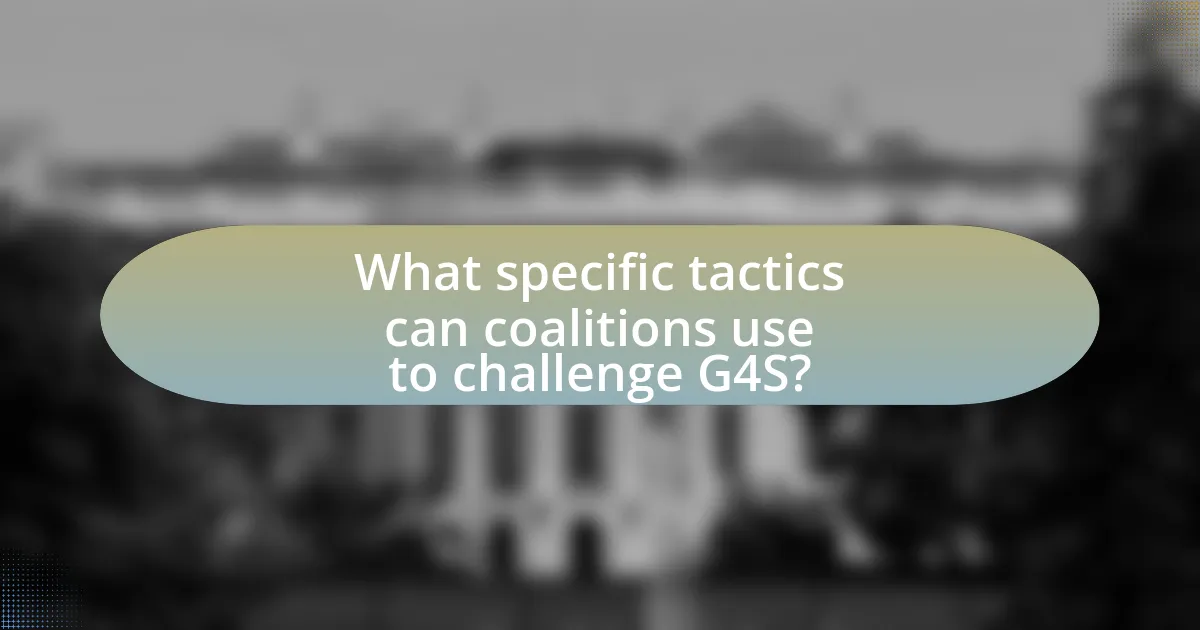
What specific tactics can coalitions use to challenge G4S?
Coalitions can use public awareness campaigns to challenge G4S by highlighting its controversial practices and human rights violations. These campaigns can include organizing protests, leveraging social media to disseminate information, and engaging in community outreach to educate the public about G4S’s impact. For instance, the coalition can utilize statistics from credible sources, such as Amnesty International, which has documented G4S’s involvement in detention centers and security operations linked to human rights abuses. By mobilizing public opinion and creating pressure through these tactics, coalitions can effectively challenge G4S’s operations and reputation.
What advocacy strategies are most effective in opposing G4S?
Effective advocacy strategies in opposing G4S include coalition-building, public awareness campaigns, and targeted lobbying efforts. Coalition-building allows diverse groups, such as human rights organizations, labor unions, and community activists, to unite their resources and amplify their voices against G4S’s practices. Public awareness campaigns leverage social media and traditional media to inform the public about G4S’s controversial activities, such as its involvement in immigration detention and security services in conflict zones, which can lead to increased public pressure. Targeted lobbying efforts focus on influencing policymakers to enact legislation that restricts G4S’s operations or holds the company accountable for its actions. These strategies have been validated by successful movements that have led to divestment from G4S by various institutions, demonstrating their effectiveness in creating change.
How can coalitions leverage public awareness campaigns?
Coalitions can leverage public awareness campaigns by strategically uniting diverse groups to amplify their message and reach a broader audience. By collaborating on campaigns, coalitions can pool resources, share expertise, and create a unified narrative that resonates with the public. For instance, a coalition opposing G4S can utilize social media platforms, community events, and partnerships with local organizations to raise awareness about their cause, thereby increasing visibility and engagement. Research indicates that coalitions that effectively communicate their objectives through public awareness campaigns can enhance public support and influence policy changes, as seen in various social movements that successfully mobilized community action through targeted outreach efforts.
What role does grassroots organizing play in coalition efforts?
Grassroots organizing is essential in coalition efforts as it mobilizes community members to advocate for shared goals. This form of organizing fosters local engagement, builds trust among diverse groups, and amplifies voices that may otherwise be marginalized. For instance, grassroots movements have historically led to significant social changes, such as the Civil Rights Movement, where local activists united various organizations to challenge systemic injustices. By leveraging the collective power of individuals, grassroots organizing enhances the effectiveness and sustainability of coalitions, ensuring that they reflect the needs and aspirations of the communities they represent.
How can coalitions engage with policymakers to influence change?
Coalitions can engage with policymakers to influence change by presenting unified positions and evidence-based recommendations that align with the policymakers’ goals. By conducting thorough research and gathering data on issues relevant to their cause, coalitions can create compelling arguments that demonstrate the need for specific policy changes. For instance, coalitions can leverage case studies or statistics that highlight the impact of existing policies and the benefits of proposed changes, thereby making a persuasive case for action. Additionally, coalitions can organize meetings, public forums, and advocacy campaigns to raise awareness and mobilize public support, which can further pressure policymakers to consider their proposals.
What approaches can be taken to lobby effectively against G4S?
To lobby effectively against G4S, organizations should focus on building coalitions that unite diverse groups, such as human rights activists, labor unions, and community organizations. This collaborative approach amplifies voices and resources, increasing pressure on G4S. For instance, the coalition can organize public demonstrations, leveraging social media campaigns to raise awareness about G4S’s controversial practices, such as its involvement in immigration detention and security operations in conflict zones. Evidence of successful lobbying can be seen in the campaigns led by groups like the Stop G4S campaign, which has effectively mobilized public opinion and influenced policy discussions regarding the company’s contracts.
How can coalitions build relationships with key stakeholders?
Coalitions can build relationships with key stakeholders by engaging in consistent communication and collaboration. Establishing regular dialogue fosters trust and understanding, which are essential for effective partnerships. For instance, coalitions can organize stakeholder meetings, workshops, or forums to discuss shared goals and challenges, thereby creating a platform for open exchange. Research indicates that organizations that prioritize stakeholder engagement see a 30% increase in collaborative initiatives, demonstrating the effectiveness of proactive relationship-building strategies.
What are best practices for sustaining coalitions over the long term?
Best practices for sustaining coalitions over the long term include establishing clear goals, fostering open communication, and ensuring equitable participation among members. Clear goals provide a shared vision that aligns the coalition’s efforts, while open communication facilitates trust and collaboration. Equitable participation ensures that all voices are heard, which strengthens commitment and engagement. Research indicates that coalitions with defined objectives and inclusive practices are more likely to endure, as evidenced by studies showing that successful coalitions often maintain member satisfaction and active involvement over time.
How can coalitions ensure inclusivity and representation among members?
Coalitions can ensure inclusivity and representation among members by implementing structured outreach and engagement strategies that actively involve diverse voices. This can include conducting surveys to identify underrepresented groups, facilitating open forums for discussion, and establishing advisory committees that reflect the coalition’s demographic diversity. Research indicates that inclusive coalitions are more effective; for instance, a study by the National Coalition for Dialogue & Deliberation found that diverse participation leads to more innovative solutions and greater community trust. By prioritizing these practices, coalitions can create an environment where all members feel valued and represented.
What mechanisms can be established for conflict resolution within coalitions?
Effective mechanisms for conflict resolution within coalitions include mediation, negotiation, and the establishment of clear communication channels. Mediation involves a neutral third party facilitating discussions to help conflicting parties reach a mutually acceptable solution, which has been shown to reduce tensions and foster collaboration. Negotiation allows coalition members to directly address their differences and find common ground, often leading to compromises that satisfy all parties involved. Additionally, clear communication channels ensure that all members can express their concerns and perspectives openly, which is critical for preventing misunderstandings and escalating conflicts. Research indicates that coalitions with structured conflict resolution processes are more successful in achieving their goals and maintaining unity.
